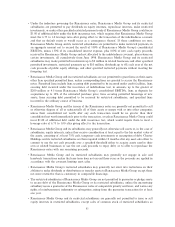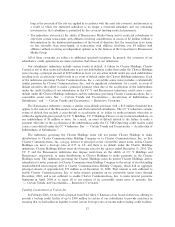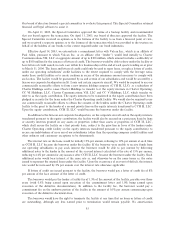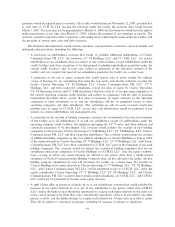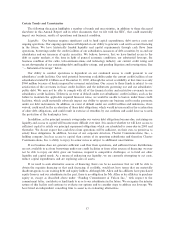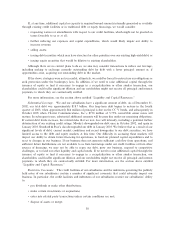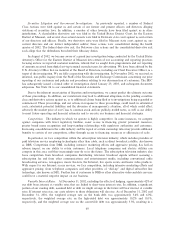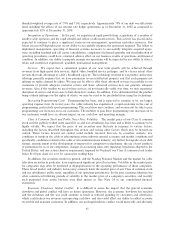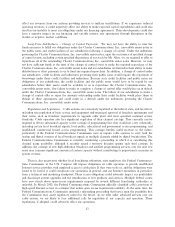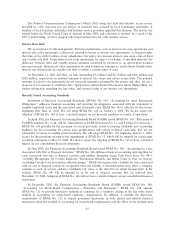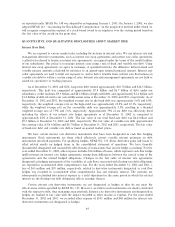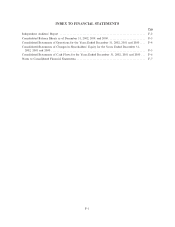Charter 2002 Annual Report Download - page 60
Download and view the complete annual report
Please find page 60 of the 2002 Charter annual report below. You can navigate through the pages in the report by either clicking on the pages listed below, or by using the keyword search tool below to find specific information within the annual report.If, at any time, additional capital or capacity is required beyond amounts internally generated or available
through existing credit facilities or in traditional debt or equity Ñnancings, we would consider:
‚ requesting waivers or amendments with respect to our credit facilities, which might not be granted on
terms favorable to us or at all;
‚ further reducing our expenses and capital expenditures, which would likely impair our ability to
increase revenue;
‚ selling assets;
‚ issuing debt securities which may have structural or other priorities over our existing high-yield debt; or
‚ issuing equity securities that would be dilutive to existing shareholders.
Although there are no current plans to do so, we also may consider transactions to reduce our leverage,
including seeking to exchange currently outstanding debt for debt with a lower principal amount or, if
opportunities arise, acquiring our outstanding debt in the market.
If the above strategies were not successful, ultimately, we could be forced to restructure our obligations or
seek protection under the bankruptcy laws. In addition, if we need to raise additional capital through the
issuance of equity or Ñnd it necessary to engage in a recapitalization or other similar transaction, our
shareholders could suÅer signiÑcant dilution and our noteholders might not receive all principal and interest
payments to which they are contractually entitled.
For more information, see the section above entitled ""Liquidity and Capital Resources.''
Substantial Leverage. We and our subsidiaries have a signiÑcant amount of debt. As of December 31,
2002, our total debt was approximately $18.7 billion. Our long-term debt begins to mature in the fourth
quarter of 2003, when approximately $66 million of principal is due on the CC V bonds, and subsequently in
October 2005 when Charter Communications, Inc.'s $750 million of 5.75% convertible senior notes will
mature. In subsequent years, substantial additional amounts will become due under our remaining obligations.
If current debt levels increase, the related risks that we now face will intensify, including a potential further
deterioration of our existing credit ratings. Moody's downgraded our debt once in October 2002, and again in
January 2003. Standard & Poor's also downgraded our debt in January 2003. We believe that as a result of our
signiÑcant levels of debt, current market conditions and recent downgrades to our debt securities, we have
limited access to the debt and equity markets at this time. Our diÇculty in accessing these markets will
impact our ability to obtain future Ñnancing for operations, to fund our planned capital expenditures and to
react to changes in our business. If our business does not generate suÇcient cash Öow from operations, and
suÇcient future distributions are not available to us from borrowings under our credit facilities or from other
sources of Ñnancing, we may not be able to repay our debt, grow our business, respond to competitive
challenges, or to fund our other liquidity and capital needs. If we need to raise additional capital through the
issuance of equity or Ñnd it necessary to engage in a recapitalization or other similar transaction, our
shareholders could suÅer signiÑcant dilution and our noteholders might not receive all principal and interest
payments to which they are contractually entitled. For more information, see the section above entitled
""Liquidity and Capital Resources.''
Restrictive Covenants. The credit facilities of our subsidiaries and the indentures governing the publicly
held notes of our subsidiaries contain a number of signiÑcant covenants that could adversely impact our
business. In particular, the credit facilities and indentures of our subsidiaries restrict our subsidiaries' ability
to:
‚ pay dividends or make other distributions;
‚ make certain investments or acquisitions;
‚ enter into related party transactions unless certain conditions are met;
‚ dispose of assets or merge;
58





